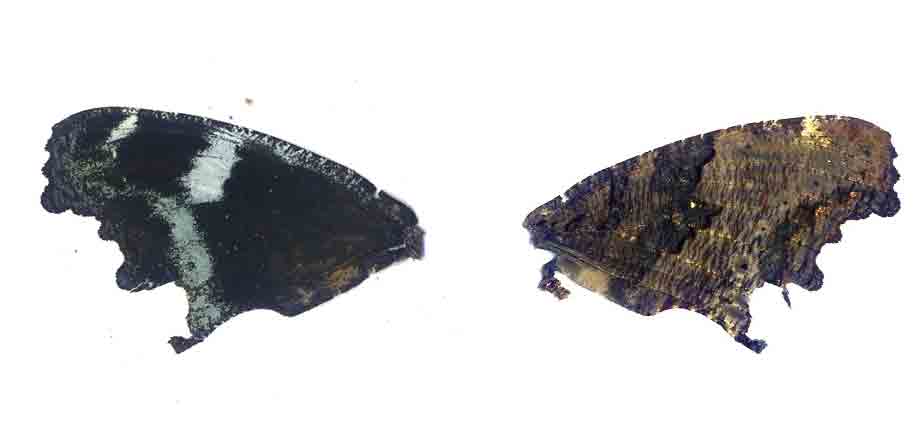
|
|
|
カテゴリ:日常雑感
今朝、いつものように落葉掃きをしていると、落葉の中に青緑色のメタリックな輝きをしている小さな破片が混じっていることに気付いた。 私は、何だろう?、と思い、身を屈めて指先で拾い上げた。裏を返してみると朽ち葉色をしていた。わずか3センチ長さのものだが、蝶の翅である。我家の近辺で見たことがない蝶である。 あとで調べてみようと思い、左の掌にのせたまま、右手で植木鉢の枯葉を摘み取りつづけた。が、気がつくと蝶の翅がどこかに飛んでしまっていた。私は身を屈め目をこらして20分ばかり辺りを探したが見つからなかった。翅の裏が朽ち葉そっくりな蝶の翅は、落ち葉の山にまぎれこんでは見つけるのは容易ではない。 諦めて家に入り、朝食を摂り、仕事場に入った。書棚から『日本蝶類図鑑』を取り出し、ページを繰りながら、もう一度失った翅を探してみるきになった。 庭を這うように探し、なんと、ついにあの小さな朽ち葉色の翅裏を見つけたのだ。 私の執念! 老年になってもこういうことに関しての自分の執念を自嘲気味に思いながら、私は両掌のドームの中に大事に蝶の翅を収めて仕事場に戻った。 写真撮影をし、再び図鑑を調べ、「るりたては(Kaniska canace no-japonicum SIEBOLD 1824)」であることを突止めた。シーボルト博士が1824年に日本で発見し、命名した蝶である。 この蝶は東洋特産種であるが、なぜかメキシコの山中にぽつりと孤児のように存在する。ヨーロッパにはまったく存在しない。学名中の「no-Japonicum」は、日本特産ではないという意味であろう。ついでながら、シーボルトが来日したのは1823年の8月で、翌1824年に出島外に鳴滝塾を開設した。「るりたては」の発見はこの年であったことが学名から判る。 毎年我家の小庭に飛来する蝶のなかに、「るりたては」は、これまで見なかった。図鑑によれば追飛するので捕獲が困難とある。先日の台風で体躯をばらばらにされ、ただ一片の小さな翅だけが我家に辿り着いたのかもしれない。 死してなお青空染むる秋の蝶 青穹  「るりたては」左上翅 表と裏 This morning, when I was sweeping the fallen leaves, I noticed that there was a small piece of blue-green metallic glitter in the leaves. What is this? I bend myself and picked it up with my fingertips. When I turned the other side back, it was a decayed leaf color. Although it is only 3 cm long, it is a butterfly wing. A butterfly I have never seen in my neighborhood. I decided to check it later and kept picking the ded leaves of the flowerpot with my right hand while I put it on my left palm. However, when I noticed, the but- terfly wing flew somewhere. I crouched and looked around for 20 minutes but could not find it. The back of the wing is just like a decayed leaf, so it's not easy to find it by squeezing it into a pile of fallen leaves. I gave up, entered the house, had breakfast, and entered the atelier. I took the " Japanese Butterfly Picture Book" from the bookshelf and going through the pages I want to find lost wing again. So I looked like I crawl the garden, and finally I found the small decayed leaf-colored wing. My obsession! Even when I was aged, I felt reluc- tant about my obsession with such things. and I put a butterfly wing in the dome of both palms and returned to the atelier. I took pictures, checked the picture book again, and determined that it was " Kaniska canace no- japonicum SIEBOLD 1824". The butterfly that Dr. Siebold discovered and named in Japan. This butterfly is an oriental special species, but for some reason it exists like a lonly orphan in the mountains of Mexico. It doesn't exist at all in Europe. The name "no-Japonicum" may mean that it is not a Japanese specialty. By the way, Siebold came to Japan in August 1823, and in 1824 the next year, Narutaki Juku (The Narutaki Private School) was opened out- side Dejima, Nagasaki. It is clear from the sci- entific name that the discovery of "Ruritateha" was this year. In the butterflies that fly to my garden every year, I have never seen " Ruritateha". According to the pictorial book, it is difficult to capture because it flies away. The other day the typhoon may have broken her body apart, and only a small piece of wings may have arrived at my home. Autumn butterfly dyes the color of the blue sky and yet in its dead by Séikyu (Tadami Yamada) お気に入りの記事を「いいね!」で応援しよう
Last updated
Oct 22, 2019 01:05:51 PM
コメント(0) | コメントを書く
[日常雑感] カテゴリの最新記事
|
|